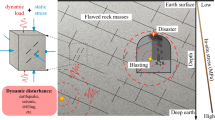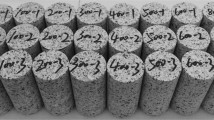Abstract
In the process of geothermal energy exploitation, the fracture surface of hot dry rocks (HDRs) is easily damaged by repeated injection of cold water. To reveal the damage and flow characteristics of granite fracture surfaces with shear and tension, Brazilian split tests, shear tests, three-dimensional laser scanning tests, repeated thermal shock tests, and fracture surface fluid flow tests are carried out in this study. The fracture damage of the samples is characterized by using the average roughness Ra, the root means square roughness Rrms, the fractal dimension of the fracture surface, the fractal dimension of the gap of the fracture surface, and the three-dimensional fracture surface pictures. The fluid flow characteristics of the fracture surface are characterized by the hydraulic aperture and Reynolds number. The results show that the repeated thermal shock test at 500 ℃ has the greatest influence on the fracture morphology. The variation value of the roughness coefficient of the tensile fracture is 0.0772 and that of the shear fracture is 0.0485. However, the influence of heat treatment on fluid flow in tension fractures is greater than that in shear fractures. This shows that the fluid flow in the fracture is related not only to the heat treatment but also to the fluid flow channel.
Highlights
-
Under repeated thermal shock, the section damage of tensile fractures is larger than that of shear fractures.
-
Using the fractal dimension of the section surface and the fractal dimension of the void to reveal the fluid flow characteristics of tensile fracture and shear fracture after thermal shock.
-
After repeated thermal shock, the fluid flow characteristics of the fractures are more significant as the change value of void fractal dimension increases.

















Similar content being viewed by others
Data Availability
All data, models, or code that support the findings of this study are available from the corresponding author (demonjjun@126.com) upon reasonable request.
References
Amadei B, Illangasekare T (1994) A mathematical model for flow and solute transport in non-homogeneous rock fractures. Int J Rock Mech Min Sci Geomech. 31(6):719–731
Baisch S, Vörös R, Rothert E, Stang H, Jung R, Schellschmidt R (2010) A numerical model for fluid injection induced seismicity at Soultz-Sous-Forêts. Int J Rock Mech Min 47(3):405–413
Carey JW, Lei Z, Rougier E, Mori H, Viswanathan H (2015) Fracture-permeability behavior of shale. J Unconv Oil Gas Resourc 11:27–43
Chen YD, Liang WG, Lian HJ et al (2017) Experimental study on the effect of fracture geometric characteristics on the permeability in deformable rough-walled fractures. Int J Rock Mech Min 98:121–140
Crandall D, Ahmadi G, Smith DH (2010) Computational modeling of fluid flow through a fracture in permeable rock. Transp Porous Med 84(2):493–510
Develi K, Babadagli T (2015) Experimental and visual analysis of single-phase flow through rough fracture replicas. Int J Rock Mech Min 73:139–155
Fan LF, Wu ZJ, Wan Z, Gao JW (2017) Experimental investigation of thermal effects on dynamic behavior of granite. Appl Therm Eng 125:94–103
Fan LF, Yang KC, Wang M et al (2021) Experimental study on wave propagation through granite after high-temperature treatment. Int J Rock Mech Min 148:104946
Fan LF, Qiu B, Gao JW, Du XL (2023) A real-time visual investigation on microscopic progressive fatigue deterioration of granite under cyclic loading. Rock Mech Rock Eng. https://doi.org/10.1007/s00603-023-03326-y
Ghassemi A (2012) A review of some rock mechanics issues in geothermal reservoir development. Geotech Geol Eng 30(3):647–664
Hassanizadeh SM, Gray WG (1987) High velocity flow in porous media. Transp Porous Med 2(6):521–531
Huang W, Cao W, Jiang F (2018) A single-well geothermal system for hot dry rock geothermal energy exploitation. Energy 162:630–644
Kumari WGP, Ranjith PG, Perera MSA, Chen BK, Abdulagatov IM (2017) Temperature-dependent mechanical behaviour of Australian strathbogie granite with different cooling treatments. Eng Geol 229:31–44
Li ZW, Feng XT, Zhang YJ, Zhang C, Xu TF, Wang YS (2017) Experimental research on the convection heat transfer characteristics of distilled water in manmade smooth and rough rock fractures. Energy 133:206–218
Li H, Lu Y, Zhou L, Tang J, Han S, Ao X (2018) Experimental and model studies on loading path-dependent and nonlinear gas flow behavior in shale fractures. Rock Mech Rock Eng 51(1):227–242
Li B, Ju F, Xiao M, Ning P (2019) Mechanical stability of granite as thermal energy storage material: an experimental investigation. Eng Fract Mech 211:61–69
Li N, Zhou T, Zhao MY, Wang HB, Hu XD, Zou YS, Zhang ZP (2022) Thermal-shock-induced surface softening and conductivity evolution of hydraulic fracture in enhanced geothermal system. Geothermics 102:102405
Maxwell S (2010) Microseismic: growth born from success. Leading Edge 29(3):338–343
Nazridoust K, Ahmadi G, Smith DH (2006) A new friction factor correlation for laminar, single-phase flows through rock fractures. J Hydrol 329(1–2):315–328
Park S, Xie LM, Kim K, Kwon S, Min KB, Choi J, Yoon WS, Song Y (2017) First hydraulic stimulation in fractured geothermal reservoir in Pohang Px-2 Well. Procedia Eng 191:829–837
Qiang S, Jhab C (2019) The effect of rapid cooling on the thermal diffusivity of granite. J Appl Geophys 168:71–78
Ranjith PG, Darlington W (2007) Nonlinear single-phase flow in real rock joints. Water Resour Res 43(9):146–156
Ranjith PG, Viete DR (2011) Applicability of the “Cubic Law” for non-Darcian fracture flow. J Petrol Sci Eng 78(2):321–327
Riahi A, Damjanac B (2013) Numerical study of hydro-shearing in geothermal reservoirs with a pre-existing discrete fracture network
Rong G, Peng J, Ming C, Yao M, Zhou C, Sha S (2018) Experimental investigation of thermal cycling effect on physical and mechanical properties of bedrocks in geothermal fields. Appl Therm Eng 141:174–185
Shen M, Bi J, Zhao Y, Wang C, Wei T, Du B (2022) Study on the mechanical characteristics and damage evaluation of concrete-rock combination after high temperatures exposure. Constr Build Mater 330:127278
Shi Y, Song X, Li J, Wang G, Zheng R, Feixue YL (2019) Numerical investigation on heat extraction performance of a multilateral-well enhanced geothermal system with a discrete fracture network. Fuel 244:207–226
Singh KK, Singh DN, Ranjith PG (2015) Laboratory simulation of flow through single fractured granite. Rock Mech Rock Eng 48(3):987–1000
Snow DT (1969) Anisotropic permeability of fractured media. Water Resour Res 5(6):1273–1289
Su XP, Zhou L, Li H, Xia BW, Shen ZH, Lu YY (2019) Experimental and numerical modelling of nonlinear flow behavior in single fractured granite. Geofluids 2019:1–20
Tang ZC, Sun M, Peng J (2019) Influence of high temperature duration on physical, thermal and mechanical properties of a fine-grained marble. Appl Therm Eng 156:34–50
Tenma N, Yamaguchi T, Zyvoloski G (2008) The Hijiori hot dry rock test site, Japan. Geothermics 37:19–52
Wu X, Huang Z, Li R, Zhang S, Zhang C (2018) Investigation on the damage of high-temperature shale subjected to liquid nitrogen cooling. J Nat Gas Sci Eng 57:284–294
Wu X, Huang Z, Cheng Z, Zhang S, Zhao X (2019) Effects of cyclic heating and Ln2-cooling on the physical and mechanical properties of granite. Appl Therm Eng 156:99–110
Yang QH, Fan LF, Du XL (2022) Determination of wave propagation coefficients of the granite by high-speed digital image correlation (HDIC). Rock Mech Rock Eng 55:4497–4505
Yang QH, Wang M, Zhao X, Fan LF (2023) Experimental study of frequency-temperature coupling effects on wave propagation through granite. Int J Rock Mech Min 162:105326
Zhang Z, Nemcik J (2013) Friction factor of water flow through rough rock fractures. Rock Mech Rock Eng 46:1125–1134
Zhang W, Sun Q, Hao S, Geng J, Lv C (2016) Experimental study on the variation of physical and mechanical properties of rock after high temperature treatment. Appl Therm Eng 98:1297–1304
Zhang F, Zhao J, Hu D, Skoczylas F, Shao J (2017a) Laboratory investigation on physical and mechanical properties of granite after heating and water-cooling treatment. Rock Mech Rock Eng 51:677–694
Zhang L, Jiang P, Wang Z, Xu R (2017b) Convective heat transfer of supercritical Co2 in a rock fracture for enhanced geothermal systems. Appl Therm Eng 115:923–936
Zhang W, Guo TK, Qu ZQ, Wang Z (2019) Research of fracture initiation and propagation in Hdr fracturing under thermal stress from meso-damage perspective. Energy 178:508–521
Zhang YF, Long AF, Zhao Y, Zang A, Wang CL (2023) Mutual impact of true triaxial stress, borehole orientation and bedding inclination on laboratory hydraulic fracturing of Lushan shale. J Rock Mech Geotech. https://doi.org/10.1016/j.jrmge.2023.02.015
Zhao Y, Zhang Y, Yang H, Yang HQ, Liu Q, Tian GD (2022a) Experimental study on relationship between fracture propagation and pumping parameters under constant pressure injection conditions. Fuel 307:121789
Zhao Y, Zhang YF, Tian GD, Wang CL, Bi J (2022b) A new model for predicting hydraulic fracture penetration or termination at an orthogonal interface between dissimilar formations. Petrol Sci 19:2810–2829
Zhao Y, Wang CL, Ning L, Zhao HF, Bi J (2022c) Pore and fracture development in coal under stress conditions based on nuclear magnetic resonance and fractal theory. Fuel 309:122112
Zhou HW, Xie HP (2003) Direct estimation of the fractal dimensions of a fracture surface of rock. Surf Rev Lett 10(05):751–762
Zhou L, Su XP, Hou Z, Lu Y, Gou Y (2016) Numerical investigation of the hydromechanical response of a natural fracture during fluid injection using an efficient sequential coupling model. Environ Earth Sci 75(18):1263
Acknowledgements
This work was supported by National Natural Science Foundation of China (52164001, 52064006 and 52004072), Science and Technology Support Project of Guizhou ([2020] 4Y044), [2021] N404 and [2021] N511), Talents of Guizhou University (Grant No. 201901), the Special Research Funds of Guizhou University (Grant Nos. 201903, 202011, 202012), Guizhou University Cultivation Program ([2020] No. 1), Higher Education research project of Guizhou University (GDGJYJ2021009).
Author information
Authors and Affiliations
Corresponding author
Ethics declarations
Conflict of Interest
The authors declared that they have no conflicts of interest in this work. We declare that we do not have any commercial or associative interest that represents a conflict of interest in connection with the work submitted.
Additional information
Publisher's Note
Springer Nature remains neutral with regard to jurisdictional claims in published maps and institutional affiliations.
Rights and permissions
Springer Nature or its licensor (e.g. a society or other partner) holds exclusive rights to this article under a publishing agreement with the author(s) or other rightsholder(s); author self-archiving of the accepted manuscript version of this article is solely governed by the terms of such publishing agreement and applicable law.
About this article
Cite this article
Deng, X., Zhao, Y., Bi, J. et al. Study on Fracture Surface Damage and Fluid Flow Characteristics of Hot Dry Rock with Different Failure Modes under Repeated Thermal Shock. Rock Mech Rock Eng 56, 8789–8808 (2023). https://doi.org/10.1007/s00603-023-03526-6
Received:
Accepted:
Published:
Issue Date:
DOI: https://doi.org/10.1007/s00603-023-03526-6




